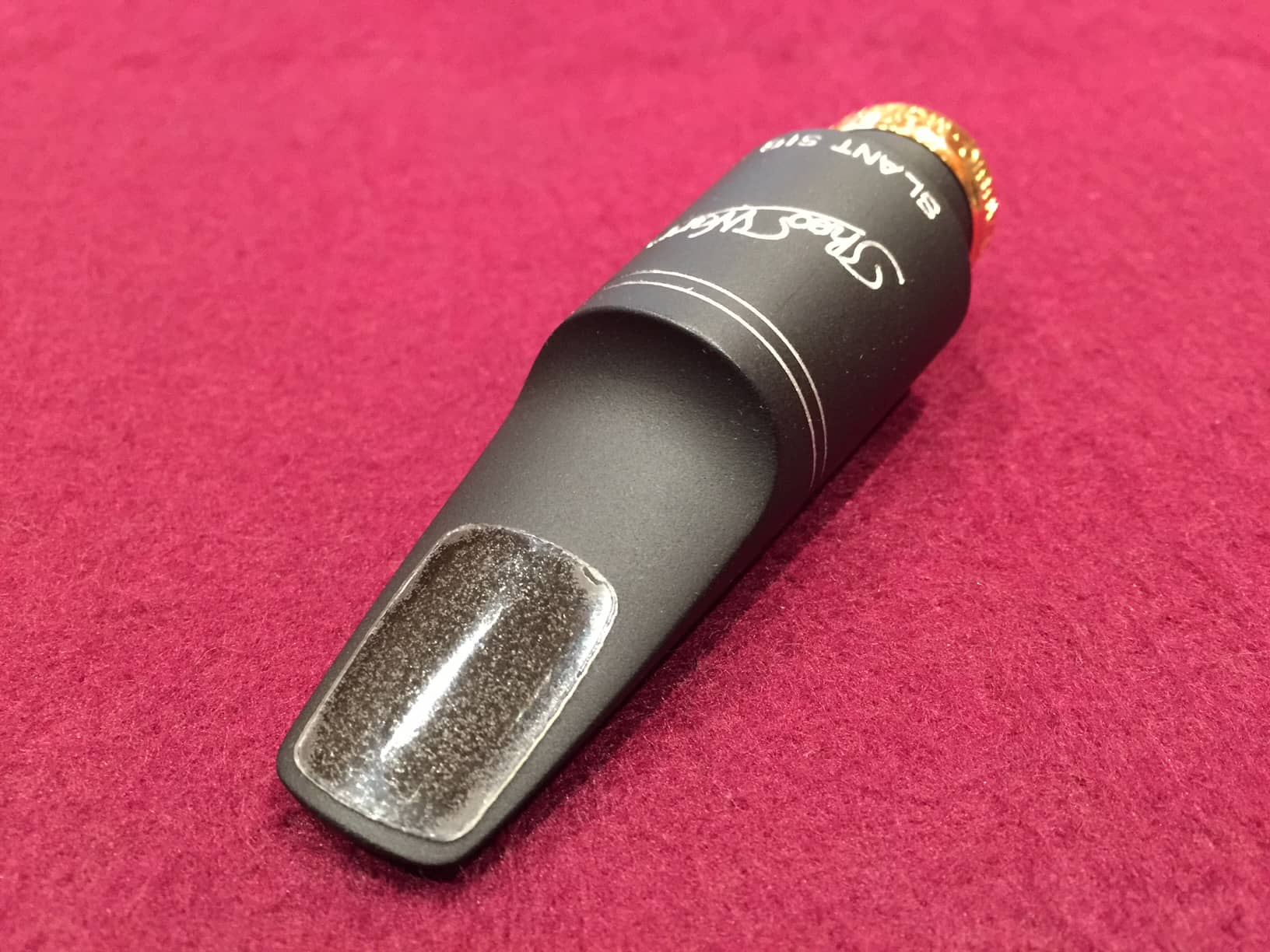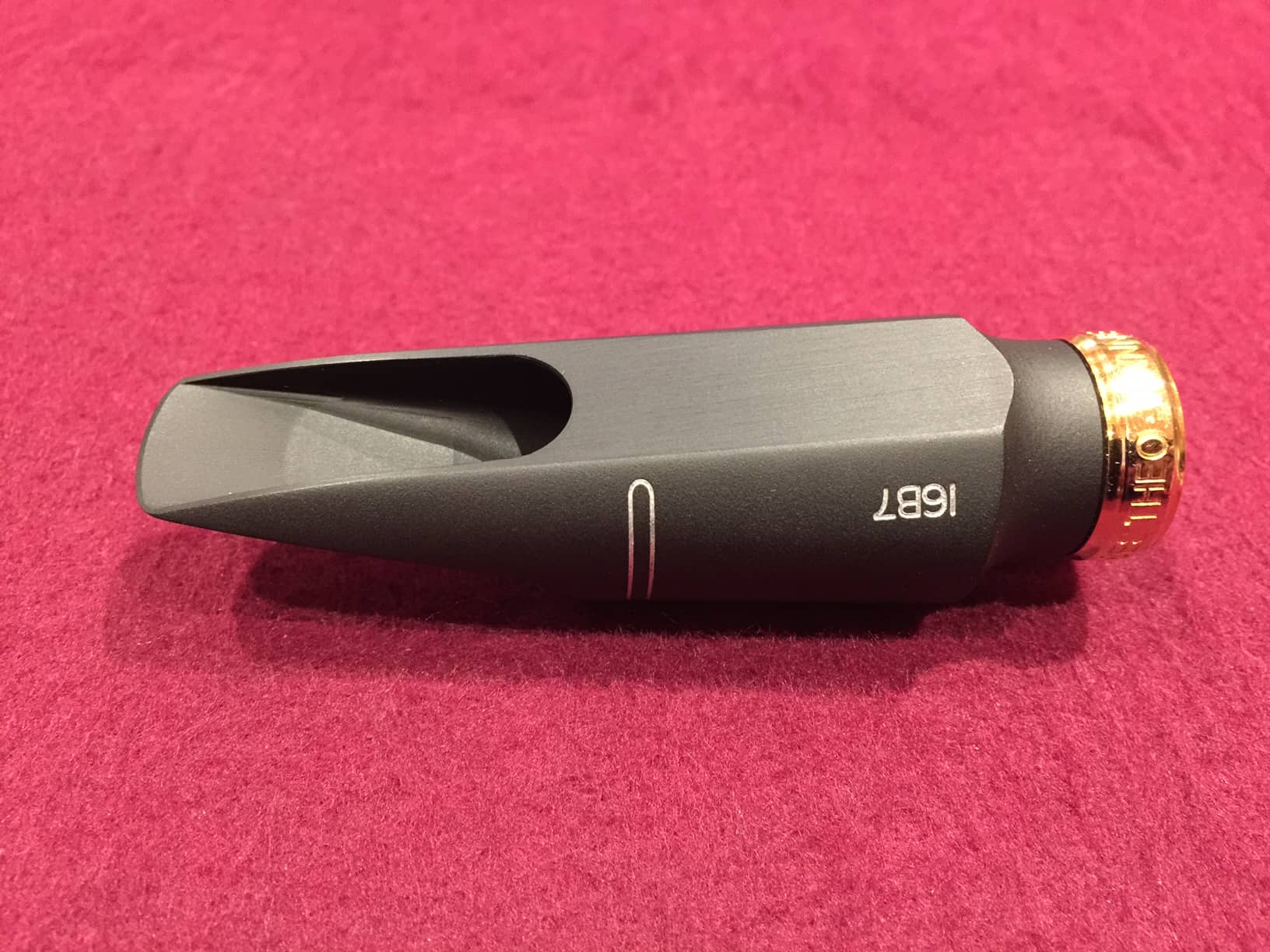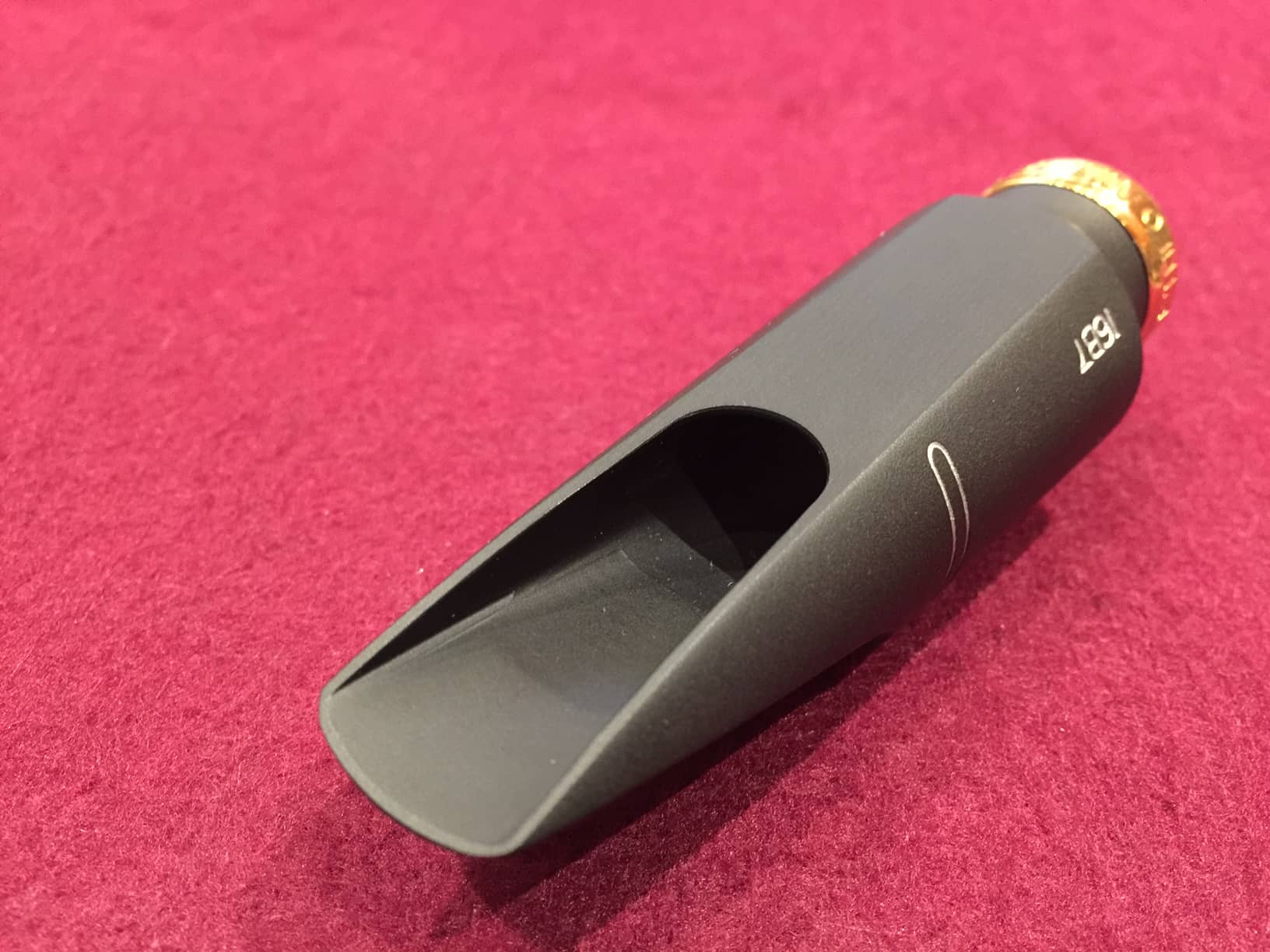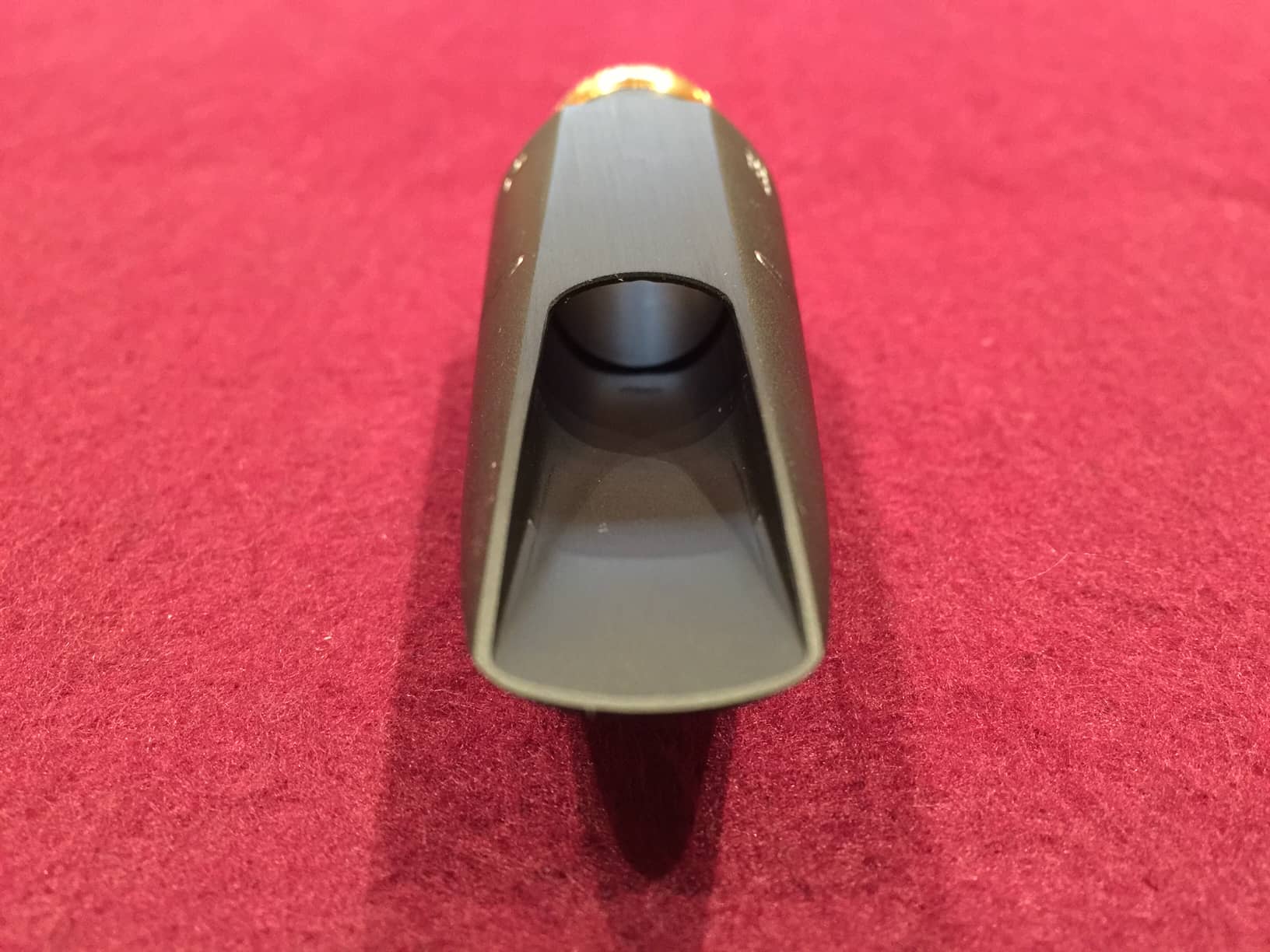Today, I am reviewing another great saxophone mouthpiece made by Theo Wanne at TheoWanne.com (save 15% by using this link). Theo Wanne was one of the first sax mouthpiece makers to reach out to me and ask if I would be willing to do some reviews of his mouthpieces years ago. I had heard his name for years as the guy to go to for mouthpiece work and when he started his own line of sax mouthpieces I had to try them out! I have reviewed many of his mouthpiece on this site and if you put “Theo Wanne” in the search box to the top right of the site you will find them. Theo Wanne’s saxophone mouthpieces are innovative and some of the best playing sax mouthpieces on the market today.
This review is on the Slant 2 7* tenor saxophone mouthpiece. I had never played the first version of the TW Slant so I can’t speak about the differences between the two mouthpieces unfortunately.
Theo Wanne 7* Slant 2 Tenor Saxophone Mouthpiece
Over the last few years there has been a lot of buzz in the saxophone world around certain buzz words. Saxophone player’s ears perk up when you mention florida link, double ring, slant signature, NY Meyer, etc…….. There is a certain mystique and awe around these mouthpieces in the marketplace that is hard to deny.
Here’s a description from Theo Wanne’s website about the Slant 2 tenor sax mouthpiece:
The BRAND NEW Theo Wanne™ Slant Sig Tenor Mouthpiece brings the best of vintage tenor mouthpiece designs to the future! Theo Wanne is the world’s foremost expert on vintage sax mouthpieces and he understands WHY an Otto Link sounds great. So, Theo utilized the best design principles from the first Slant Signature models in the early 1950s through the Early Babbitt models in the 1970s to make the new Theo Wanne™ Slant Sig Tenor Mouthpiece. It is the ultimate vintage Slant Sig Link.
The Slant Sig mouthpiece is the perfect mouthpiece for students and pros alike, allowing the player to get the ‘classic’ tenor sound AND be fully expressive. Hear more about the history of Otto Link and the Slant Sig concept here!
You also asked for Theo Wanne™ quality and design at a very friendly price everyone could afford. So we did that too!!!
SOUND
- Versatile! Great for all styles and types of playing.
- The most expressive and most projecting Slant Signature Otto Link sound you’ve ever heard!
DESIGN
- Perfectly sculpted large chamber and roll-over baffle.
- Crafted to the highest accuracy in the history of Otto Link style mouthpieces; perfect side and tip rails!
- Designed by Theo Wanne, the foremost expert on the design and manufacturing of vintage mouthpieces. Incorporating the best features of every Slant Signature Otto Link, from the 1950’s through 1970s.
DETAILS
- Premium Harry Hartmann Fiberrod™: Manufactured with a special formulation of Harry Hartmann Fiberrod™, made especially for Theo Wanne™, to sound and look just like vintage hard rubber but does not discolor and smell like hard rubber when exposed to heat and the sun.
Theo Wanne Slant 2 Tenor Saxophone Mouthpiece
The Theo Wanne Slant 2 came in the pristine packaging that I have written about in every Theo Wanne mouthpiece review I have done on this site. Beautiful box and drawstring pouch.
I’m looking at the mouthpiece now as I type this description and it looks about as perfect as could be. The table, rails, tip and baffle look smooth, even and perfectly crafted. The chamber looks slightly larger than the chamber on my vintage EB Otto Link (supposedly from the Slant mold from what I have been told) when I hold them side by side.
The Slant 2 is made of Harry Hartmann Fiberrod. I haven’t heard of this material before but it looks and feels similar to hard rubber to me. Now I’m wondering if my Gaia soprano and alto mouthpiece are made of this same material? It says nothing about the Fiberrod on the Gaia alto and soprano pages of Theo’s site so maybe those are hard rubber? Not sure………..
Theo Wanne Slant 2 Tenor Saxophone Mouthpiece
The Slant 2 was incredibly reed friendly in my opinion. Usually, this is only stated as a great thing but I found it caused some confusion for me. Let me explain, I started playing the Slant 2 with a 2 1/2 strong Rigotti and it played great, then I tried a 3 light and it played great, I tried a 3 medium and….you guessed it, it played great, 3 strong, 3 1/2 light, 3 1/2 medium………..they all played great. I have never experienced this before with a mouthpiece. I couldn’t figure out which reed to use for the demo. I recorded a clip with the 3 1/2 light and thought it was the greatest clip ever but when I listened back I thought “The reed sounds too hard.” I then recorded with a 3 light which went well but again, when I listened back……”Reed sounds too soft.” Today I tried a 3 medium and again recorded. This time when I listed back I thought it was just right…….All this is my long way of saying it is very reed friendly.
Theo Wanne Slant 2 Tenor Saxophone Mouthpiece
The first thing I noticed when playing the Theo Wanne Slant 2 mouthpiece is that the beak profile feels quite a bit lower than a hard rubber Otto Link profile. I’m one who usually feels like the profile of a hard rubber link is too high because of my years playing metal mouthpiece so for me the Slant 2 felt more comfortable than a hard rubber Otto Link.
I was also surprised by the height of the baffle in the Slant 2 mouthpiece. If you look at the picture above, you can see how high the first 3/4 of an inch is. If anything, it remind me more of some baffles I have seen in Early Babbitt Otto Links. If you have played a Early Babbitt Link you already know these can be pretty powerful and bright at times. When I compare the Slant 2 to my Early Babbitt from a Slant mold mouthpiece the baffles do look very similar in height but the Slant 2 is higher in the middle of the baffle where my Link is concave at that area. This concavity in the Otto Link baffle is caused from what we call a “clam shell” baffle. I think that line in the baffle of the Slant 2 is Theo’s copy of this “clam shell” baffle as it has that shape although I don’t see much of the concavity. I was curious to see how the Theo Wanne Slant 2 mouthpiece would play.
Theo Wanne Slant 2 Tenor Saxophone Mouthpiece
The Theo Wanne Slant 2 tenor sax mouthpiece has a rich complex sound to it. I feel like the tone has a unique dry quality to my ears. Interestingly enough, the last mouthpiece I described that way was my old Theo Wanne Gaia alto saxophone mouthpiece. I’m not even sure what that “dry” description means but that is what I hear when I listen to the clips. Many times I hear Stan Getz and Jerry Bergonzi as “dry” also if that helps with the description. (I have heard that Stan Get’s played a Slant Otto Link for some time also) I think 2:09-2:19 in the clip below is a good example to my ears.
The tone was smooth and even throughout the range and the intonation was great. When pushed the Slant 2 had a lot of power to give. The altissimo was sweet sounding to me as you can hear at the 1:52 mark in the clip below. The tone in the upper register palm keys was also also very round and beautiful in my opinion (1:01-1:07) Many times these notes can get thin and edgy with other mouthpieces.
When pushed the tone seemed to become more dense and compact. With more air I could get a more aggressive sound out of the altissimo but still controlled. (3:23-3:33)
Theo Wanne 7* Slant 2 Tenor Saxophone Mouthpiece
I really loved playing the Theo Wanne Slant 2 tenor saxophone mouthpiece. In my opinion, it has a very unique and individual sound to it. It was hard for me to define as bright or dark but it seemed to have qualities of both in it’s tone and harmonics. Listening back to the sound clip, I feel like it gives me a very different sound than many of the clips on this site which is always exciting for me to experience.
If you like the sound of the Theo Wanne Slant 2 tenor sax mouthpiece, you can order one from Theo on his website at www.theowanne.com (save 15% by using this link). Tell him Steve sent you………….Great work Theo!!
Let me know what you think in the comments below and if you try a Theo WanneSlant 2 yourself please come back and let us know your own opinion also. Thanks, Steve
Theo Wanne Slant 2 Tenor Saxophone Mouthpiece









Having listened to your sound a bit, I have to say I actually don’t like this piece. I don’t hear the mid and low range of the horn like say the Navarro or others. Kind of makes your Selmer sound like a Yamaha..Maybe a good piece for live gigs.
It is clear that the MPC sounds great and that, whatever MPC you play, this sounds good! However, I can be wrong, at least in this clip, it seems more like an MPC for Rhythm and blues; or nineties music, a wonderful sound like Brecker!
I imagine, however, hearing it, that it is a very versatile MPC and suitable for many different situations, including jazz.
For the reference to the “dry” sound, perhaps the term makes the idea of centered; but I can not see a connection with the sound of Stan Getz; about Stan Getz, it seems to me that in the clip of your review of the Aizen LS, your sound often resembles Getz, do not you think? With this MPC, however, it does not seem to me that you ever look like it.
However, since I do not know English very well, I may not have understood your reference to Getz.
By the way, between the two MPC, which one do you prefer, the Aizen LS or this Slant 2?
I prefer Aizen LS, at least hearing it played by you; I have not tried either one, unfortunately!
Neff, I have and love Brian and Eric’s House Blend from Mouthpiece Cafe which you also liked and sounded great on. Would you call this one similar in sound and feel? Something I need to try, or close enough to what I’m already happy with? Thanks!
Warren, I would say these are “close enough”. I found them similar in sound concept although I felt the Slant 2 had a more “dry” sound to it than the House Blend. As far as bright to dark though I thought they were pretty similar…….
Thank you Steve! Perhaps I’ll spare myself the never ending ‘need to know’ on this one. It does get stressful trialing and returning, though it is fun!
I hope you’ll test Stephan Kammerer’s new SK DM Origin. I’ve heard four or five players on YouTube Sound absolutely fantastic on it. Thanks for everything Neff.
Warren, I hadn’t heard of that one before, I’ll check it out! Thanks.
Ok Neff, I lied! I saw a minty ‘blemished’ 8 on Musician’s Friend and had to try it. Only 2 days in, but I’m impressed! Everyone knows Theo’s reputation but I’d never tried one (a little put off by the iconography on most of the pieces but that’s just a matter of personal taste). I believe they do not hand finish as a rule, but rather rely on what is described as super-accurate CNC. If that’s the case, this is the one and only ‘factory made’ piece I’ve tried that plays like the best of the boutique pieces. I find it somewhat brighter than the House Blend we talked about, but every bit as playable and similar sounding. I think it has a bit less resistance than the ”House.’ Like you, I’ve been more of a metal guy so I also like the beak on this one. I also agree on its reed friendliness. And it’s a beautiful thing to look at too. The embossed gold ring around the shaft is classy. Curious on the Fiberrod Steve- the tenor page https://theowanne.com/product/slant-sig-2-tenor-saxophone-mouthpiece/ states “The Slant Sig 2 uses the finest vintage style hard rubber on the planet!” For those curious, the Bonade inverted lig I got for the House Blend fits the Sig2 perfectly- much less costly than the Enlightened lig. Well, I’ll keep comparing but I think it’s a keeper. It gave me the strength to part with my MacSax FJ-IV metal that I’ve really liked. Still have my eye on that SK DMO. Have a fine weekend.
Versatility for style is there as you push air and becomes more focused or playing softer goes to the realm of classic jazz ballads. One thing is the core is not represented in the soft playing parts. Ends up being too spread and with a lot of dominance of edge. I think the singing quality of soft ballads requires more core. I found a lot of Theo Wanna pieces tip rails are very thin which makes it more efficient for playing but perhaps it contributes to reshaping the tone profile and makes the edge to mask out the core of the tone a bit too much. I think Theo loves edge and excitement and this is his tone concept. One thing to consider is that a certain ribbon mic off axis and in a certain room acoustics could end up attenuating the edge and revealing more core. So listening to recorded Stan Getz may not be a good judgement since Getz could sound different with Steve’s mic, mic position, room acoustics. I don’t know if from player’s perspective how much it could be different, i.e. Steve might have felt he listens to more core while he plays this mouthpiece.
Hi, i have a funny question, but what is the name of the song that you are playing 2:09-2:18?
Anyway, thanks for your work.. I’m really a big fan of you 😀
Chris, Thanks! That is Misty. It’s in most of the Real Books. Glad you like the site! Steve
Judging by your recording I think it has really got both ends – dark and yet nicely projected sound. Looks like I will get myself this mouthpiece. Thank you Steve.
I’m an owner of a Slant 2.
Initially I felt like the tip opening was too big (7*) because it didn’t provide enough resistance / pushback. Then again, I knew I had to adjust to playing it. I’ve been playing my TW slant 2 for a 6 months now. I’ve adjusted and here’s what I’ve found: it’s very expressive if you build your embouchure technique. If you double-lip it at the end and don’t push too hard it gets super dark and full. If you take more mouthpiece and rest your teeth on the pad you can blow tons of air through it and get piercing brightness. You can temper the brightness by simply loosening your embouchure and taking less mouthpiece. There is a slight learning curve to find the right pivot points but once you do you gain the freedom of faithfully producing any tone you want to hear – dark or bright, dynamic, constant – with this one mouthpiece. When playing staccato I get brassier and more powerful transients which resonate though the whole sax.
Thanks for the great and in-depth review Dennis. I appreciate you taking the time to add your insights on the Theo Wanne Slant 2. The best thing about your review is that you have played it for 6 months. So many players will get a mouthpiece in the mail, try it, and then send it back or sell it without allowing for the necessary time to adjust and get used to the new mouthpiece. In my opinion, these players are missing out on how magical a new mouthpiece can be when a player adapts to get the best they can out of it. Steve
I was watching a video polishing up on my sub tone and it just so happened that the guy in the video is using the TW slant 2 and double-lipping! Had to come back and share. And thanks for the nice response! https://youtu.be/DocnmZ113R8
I have been playing this mouthpiece on and off for years. I play a 6* and this too, at least for me, is free blowing. It feels like it would need a much harder reed, I use a Rigotti 3 Medium, to give me comfortable resistance. HOWEVER, the altissimo is more accessible.
Also initially I saw, Large Chamber, and thought dark…I’ve learned; along with the baffle maybe this is why it performs well in altissimo.
I think it is just outside of my ability. But, I can’t bring myself to sell it. Lets call it….Hope.
Thanks for the review
Enjoy playing this mouthpiece when I’m looking for a more traditional sound with great projection. I have played this mouthpiece in both traditional jazz as well as R&B and smooth jazz settings and it works well in both.Mouthpiece is reed friendly as I have played Rigotti Gold,Rico Royal and Daddario 2 1/2 and 3 reeds.The quality is great with this affordably priced mouthpiece.